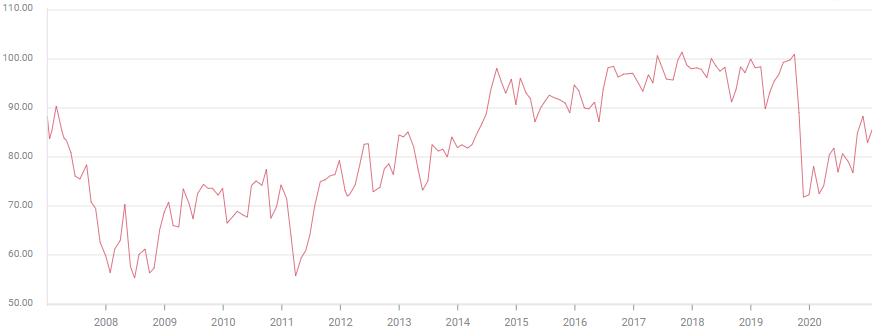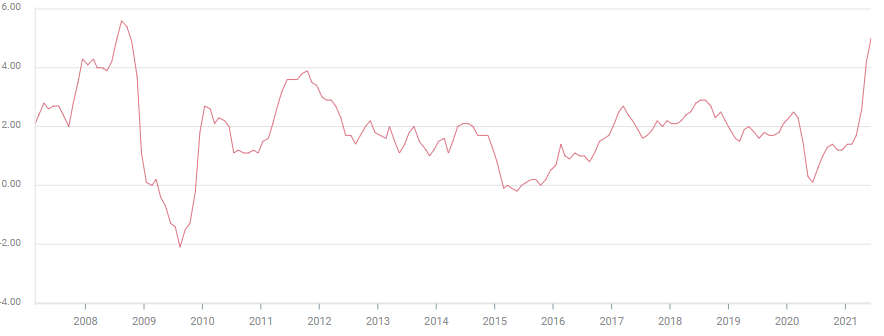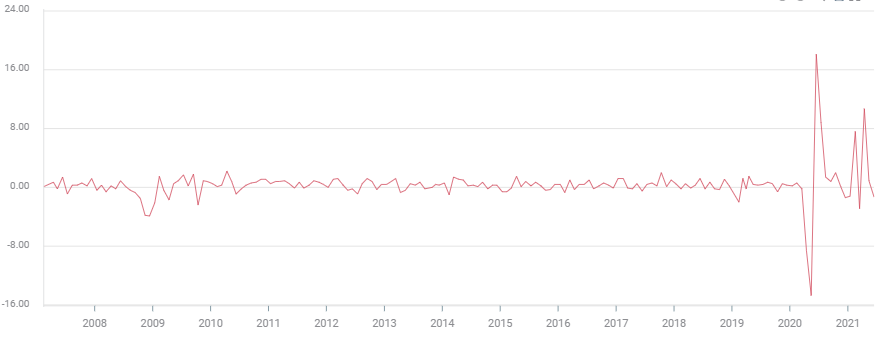- Conference Board Consumer Confidence expected to rise to 119.0 from 117.2.
- US consumer optimism may be hindered by slow employment and soaring inflation.
- Michigan Consumer Sentiment has barely stirred in the last four months.
- Markets will not trade changes in consumer outlook.
American's outlook will be little changed as the summer starts, with a slowly improving employment picture at odds with the bite of rising inflation on the family budget.
The Consumer Confidence Index from the Conference Board is expected to rise slightly to 119 in June from 117.2 in May. Consumer sentiment has recovered about two-thirds of the February 2020 to April pandemic plunge from 132.60 to 85.7. The majority of the rise has occured in the past three months as the index jumped from 95.2 in February to 114.9 in March.
Michigan Consumer Sentiment
The Consumer Sentiment Index from the University of Michigan has moved in a narrow 5.4 range since March with April the high at 88.3 followed by the low of 82.9 in May. The June score of 85.5 is almost half-way between the February 2020 reading of 101 and the April low of 71.8.
Michigan Consumer Sentiment
Employment
Although by Nonfarm Payroll accounting only 66% of the lockdown layoffs of last March and April have been rehired through May, with 9.286 million jobs going begging in the April Jobs Openings and Turnover Survey (JOLTS), it is not for lack of opportunity. Employers have reported for several months that labor shortages are one of the chief constraints in expanding business.
A combination of extended and fortified federal unemployment benefits that are scheduled to run through the end of September have induced people to delay their return to work. For many lower wage jobs, insurance may pay nearly as much as employment, making the reluctance eminently logical.
Inflation and Retail Sales
Price increases have taken a larger bite out of the consumer budget in the past several months than at any time in the last decade.
The Consumer Price Index jumped 5% annually in June, its biggest surge since August 2008. The yearly Personal Consumption Price Index (PCE) rose 3.9% in May. The core PCE rate, targeted by the Federal Reserve at 2%, climbed 3.4% last month.
CPI
FXStreet
The inflation drag on household financing may be partly responsible for the volatility in Retail Sales this year. Except for the stimulus boosted spending in January and March of 7.6% and 10.7% respectively, consumers have been chary of expenses. Retail Sales fell 2.9% in February, were up 0.9% in April and slipped 1.3% in May.
Retail Sales
The overall average monthly increase of 3% in the first five months is wholly due to the government largesse in the first quarter.
Federal Reserve Chair Jerome Powell has insisted that the current inflation is a temporary phenomenon, prompted by the base effects on prices and shortages in production and material from from last year’s lockdowns.
While there is undoubted accuracy in the Fed’s analysis there are signs that many of the price gains have become endemic in the economy.
Gasoline prices, a major component in any American family's budget, are up more than 40% this year since the elections. With global demand expected to rise and supply curtailed by US domestic policy, prices are unlikely to come down anytime soon.
Conclusion
Despite the Fed’s reassurance that inflation will diminish and employment will fully recover, Americans are taking a sensible wait-and-see attitude.
Consumer spending reflects this practical approach. When the money does not come from the family budget it is spent freely. When spending depends on income, restraint and prudence are the orders of the day.
Americans are a pragmatic people. They may believe the best for the future but they will act only when it matches reality.
Information on these pages contains forward-looking statements that involve risks and uncertainties. Markets and instruments profiled on this page are for informational purposes only and should not in any way come across as a recommendation to buy or sell in these assets. You should do your own thorough research before making any investment decisions. FXStreet does not in any way guarantee that this information is free from mistakes, errors, or material misstatements. It also does not guarantee that this information is of a timely nature. Investing in Open Markets involves a great deal of risk, including the loss of all or a portion of your investment, as well as emotional distress. All risks, losses and costs associated with investing, including total loss of principal, are your responsibility. The views and opinions expressed in this article are those of the authors and do not necessarily reflect the official policy or position of FXStreet nor its advertisers. The author will not be held responsible for information that is found at the end of links posted on this page.
If not otherwise explicitly mentioned in the body of the article, at the time of writing, the author has no position in any stock mentioned in this article and no business relationship with any company mentioned. The author has not received compensation for writing this article, other than from FXStreet.
FXStreet and the author do not provide personalized recommendations. The author makes no representations as to the accuracy, completeness, or suitability of this information. FXStreet and the author will not be liable for any errors, omissions or any losses, injuries or damages arising from this information and its display or use. Errors and omissions excepted.
The author and FXStreet are not registered investment advisors and nothing in this article is intended to be investment advice.
Recommended Content
Editors’ Picks

AUD/USD stays firm near 0.6300 after strong Chinese exports data
AUD/USD is trading well bid near 0.6300 in Asian trades on Monday, opening the week on the front foot. Risk sentiment remains in a sweeter spot following the weekend's news of lower US tariffs on Chinese electronic supply chain and strong Chinese exports data for March. Tariffs talks will remain on the radar.

USD/JPY recovers to 143.00 amid volatile trading
USD/JPY is trimming losses to retake 143\.00 in Monday's Asian trading. The US Dollar pauses its latest leg down, with traders digesting Trump's tariff news from the weekend. However, the Fed-BoJ policy divergence expectations underpin the Japanese Yen, keeping the weight intact on the pair.

Gold retreats from record highs of $3,245 as US Dollar finds its feet
Gold is rereating from record highs of $3,245 early Monday, extending Friday's late pullback. Reducded demand for safe-havens and a broad US Dollar rebound undermine the yellow metal amid the news of not-so-steep US tariffs on China's semiconductors and electronics.

Bitcoin is on the verge of a breakout while Ethereum and Ripple stabilize
Bitcoin price approaches its key resistance level at $85,000 on Monday; a breakout indicates a bullish trend ahead. Ethereum and Ripple found support around their key levels last week, suggesting a recovery is in the cards.

Is a recession looming?
Wall Street skyrockets after Trump announces tariff delay. But gains remain limited as Trade War with China continues. Recession odds have eased, but investors remain fearful. The worst may not be over, deeper market wounds still possible.

The Best brokers to trade EUR/USD
SPONSORED Discover the top brokers for trading EUR/USD in 2025. Our list features brokers with competitive spreads, fast execution, and powerful platforms. Whether you're a beginner or an expert, find the right partner to navigate the dynamic Forex market.


